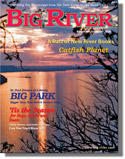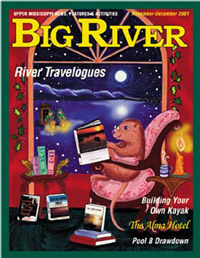
Each November, we review several recent books about the river. This bibliography and the accompanying article, Paddle and Tell, published in 2001, give an overview of earlier river travelogues.
Just nineteen at the time, Kurtz made his own boat; nearly swamped it on Lake Pepin and behind the steamboat Sprague; and almost drowned after falling between two barges in a raft.
 Big River, Nov/Dec 2001
Big River, Nov/Dec 2001
Artwork by Mi Ae Lipe-Butterbrodt
Mohlke floats the river looking for free food, free love and a free buzz -- an experience often sought by young males on the river, seldom completed and virtually never recorded.
A Mississippi River Adventure documents firsthand the shantyboat lifestyle that once was common along the river.
Among these travelogues, Raven-Hart's book provides the greatest focus on natural features, shows the most awareness of its predecessors and most extensively incorporates Twain's writings.
Order this issue or any others that are still in print
Big River Home
Subscribe to Big River
Find Big River at these stores
|

Mississippi River Travelogue Bibliography
By Curt Leitz
Big River, Nov/Dec 2001
Down the Mississippi: A 65-Year-Old Paddles a Canoe the Length of the Great River to Rediscover Himself by Leo Sheridan Anderson. Chicago: Bonus Books, Inc., 1992. 265 pp.
Aided at various stages by friends and family members, Sheridan paddles (and occasionally) sails from Lake Itasca to the Gulf of Mexico. Notable for its detailed descriptions of cold lunches, sleep schedules and marital strife.
Between the Saints: Louis and Paul by Kathy Flippo. Morrison, Mo.: Kathy Flippo, 1998. 314 pp.
Structured as a towboat trip from St. Louis to St. Paul, Flippo's narrative compiles anecdotes culled from her husband's career as a towboat captain, local histories taken from oral and printed sources, and technical information relating to river shipping. Valuable primarily for this last point, the book could have benefited from an ambitious editor.
Mississippi Solo: A River Quest by Eddy L. Harris. New York: Nick Lyons Books, 1998. 250 pp.
Harris, a travel writer, canoes from Lake Itasca to New Orleans, camping most of the way. Race relations, largely at the individual level, are treated throughout. (Harris is African-American.) The narrative focuses on the personal challenge of the trip, and Harris takes up philosophical questions more than most.
Two on the River by Will Haygood. Photographs by Stan Grossfield. Boston: Atlantic Monthly Press, 1986. 158 pp.
Haygood and Grossfield tour most of the river by car, rafting between Hannibal and Cairo, and taking a riverboat between Natchez and New Orleans. A solid coffee table book, but no more than that. The narrative is incomplete, impressionistic, and without the unity of structure and vision that most travelogues attempt.
River Journey by Clarence Jonk. New York: Stein and Day, 1964. 221 pp.
A self-styled Thoreau of the Great Depression builds a houseboat to support his Waldenic lifestyle, is forced (by unsympathetic neighbors) to leave the small Twin Cities area lake that had been his home, and floats some 150 miles from the Twin Cities to near La Crosse, Wisconsin, before being iced in. A pleasantly serendipitous narrative, not weighted down by an inexorable movement to the Gulf.
Old Man River and Me: One Man's Journey Down the Mighty Mississippi by Mark Knudsen, with Shawn Plank. Nashville: Rutledge Hill Press, 1998. 176 pp.
Knudsen builds the johnboat that he motors from St. Paul (misidentified as Minneapolis) to the Eads jetties, below New Orleans, and then back to Baton Rouge via the Intracoastal and bayou. Though he traveled a bit fast and camped too seldom for much detail on the river, Knudsen focuses on the people of the river offering dozens of colorful portraits.
Of Youth and the River by Raymond Kurtz, Sr., with Mark Scheel. Emporia, Kan.: Royal Press, 1993. 79 pp.
Kurtz recalls the high points of his 1938 adventure sailing alone from St. Paul to New Orleans. Just nineteen at the time, Kurtz made his own boat; nearly swamped it on Lake Pepin and behind the steamboat Sprague; and almost drowned after falling between two barges in a raft, passing beneath the tow, and coming up under the paddlewheel. Light and extremely entertaining reading, with evocative illustrations by Pete Peterson.
Shanty-Boat by Kent and Margaret Lighty. New York: The Century Co., 1930. 321 pp.
The Lightys navigate a small shantyboat from the Twin Cities to New Orleans to "escape from telephones and taxis, from appointments and hurry." They note many of the social and economic changes that continue to transform river towns, including corporate homogenization of culture. The book's greatest contribution is its series of portraits of diverse ways of life along the lower river.
Around the Bend: A Mississippi River Adventure by C. C. Lockwood. Baton Rouge: Louisiana State University Press, 1998. 157 pp.
A coffee table book with an essay documenting a trip from Lake Itasca to the Gulf of Mexico (by canoe to the Twin Cities, and by inflatable pontoon boat afterward). Fabulous photographs, tolerable text. It actually documents the trip other Mississippi River photographic essays construct as a useful fiction, but it's still a coffee table book.
Mississippi Odyssey by Chris Markham. Stafford, Va.: Northwoods Press, 1980. 132 pp.
In the 1970s Markham hitchhiked roads near the river from Lake Itasca to Minneapolis, then hitched rides on commercial boats to the Gulf of Mexico. A single tow took Markham from St. Paul to New Orleans, giving him an intimate view of life in the barge industry, but limiting the diversity of his river experiences. His narrative is augmented with river history and lore.
The Mighty Mississippi and the Incredible Elliot by Robert E. Matteson. St. Paul, Minn.: Robert E. Matteson, 1980. 109 pp.
The 68-year-old Matteson and his 16-year-old grandson travel from St. Paul to New Orleans by canoe, car, and towboat. Contains a moderate dose of river history, primarily from Life on the Mississippi. For the most part, brief where many other self-published travelogues are insufferably detailed. Occasionally interesting due to Matteson's background (arms control, foreign affairs, CIA, etc., as well as numerous mountaineering and wilderness adventures).
Floating Down the Country by Matthew Mohlke. Red Wing, Minn.: Lone Oak Press, Ltd., 2001. 208 pp.
Mohlke paddles from Lake Itasca to New Orleans, camping much of the way. Recently graduated from college and soured by the materialistic corporate job track he was on, Mohlke floats the river looking for free food, free love and a free buzz -- an experience often sought by young males on the river, seldom completed and virtually never recorded. The text documents the physical, emotional, moral and chemical vacillations of the liminal space between adolescence and adulthood before spiraling out of control in New Orleans.
A Mississippi River Adventure by Betty Nye. Rockford, Ill.: Betty Nye, 1992. 162 pp.
Best of the self-published accounts, this book describes the 13-month trip (including about nine months living out of the boat around Memphis) the Nye family took from Savanna, Illinois to Beaumont, Texas, via the Mississippi and Atchafalaya Rivers and the Intracoastal Waterway. Significant because it documents firsthand the shantyboat lifestyle that once was common along the river. The six-member family bought a 20-by-8-foot houseboat and started the trip when they realized they couldn't afford the next month's rent. They traveled without a plan, stopping to look for odd jobs and scrap metal when they ran out of money.
Down the Magical Mississippi by Dee and Weldon Parker. Clearlake, Calif.: Sol Seaker Publications, 1985. 311 pp.
In 1982 the Parkers navigated their cabin cruiser from Minneapolis to New Orleans, via the Atchafalaya River and the Intracoastal Waterway, meeting and befriending river folk. Often it is difficult to understand how the Parkers chose the details that appear in their narrative, and their self-published book is a good argument for an impenetrable publishing industry.
Down the Mississippi by Rowland Raven-Hart. Boston: Houghton Mifflin Company, 1938. 243 pp.
The English travel writer and avid canoeist paddles and camps between Hannibal and Baton Rouge, then buses to New Orleans for trips along bayous to the Gulf of Mexico, and (by steamer) back up to Natchez. Includes historical information on settlements along the river, much on the Mississippi's role in the Civil War, and extensive geomorphological and engineering background on the river. Among these travelogues, Raven-Hart's book provides the greatest focus on natural features, shows the most awareness of its predecessors and most extensively incorporates Twain's writings.
Mississippi Voyage: How We Rowed Down the Mississippi River in 67 Days by Curtis and Kathleen Saville. Derby Line, Vt.: Aardvark Publishing, 1986. 128 pp.
The Savilles, long-distance rowers and maritime adventurers, design, build and row an 18-foot boat from Lake Itasca to the Gulf of Mexico. This concise book documents their adventures without the burden of detailing the river's every mile.
One Good Story: A Mississippi Kayak Journey by Ron Severs. Minneapolis: Nodin Press (MicawberÕs Inc.), 2000. 148 pp.
Severs kayaks alone from Lake Itasca to the Gulf of Mexico, camping along the way. With a narrative structured thematically instead of strictly linearly, the book could have offered focused development of particular themes. However, even the overarching theme, Severs' movement from distrust of people to a renewed faith in humanity, is sporadically and incompletely developed.
The Great River Caper: Down the Mississippi Head to Toe by Edward Wright. Albuquerque: Ageless Adventures, 1995. 127 pp.
Wright canoed from Lake Itasca to Memphis (camping much of the way), rode an excursion steamboat from Memphis to New Orleans, and took a motorboat from New Orleans to the Gulf. This self-published book includes some historical information but is largely physical in its descriptions of both the river and the experience of paddling it. Good photographs are its one redeeming quality.
Copyright 2001
also see: Paddle and Tell by Curt Leitz (Big River, Nov/Dec 2001)
|


